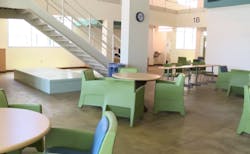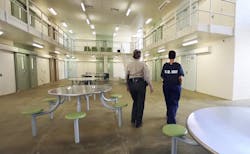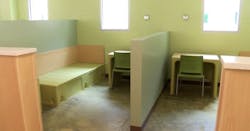San Diego prison designed with rehabilitation in mind
By BD+C Staff
Mint green walls, lime green desk chairs, and a generous number of common areas basked in natural sunlight—not the typical description of a detention center, but it does exist.
This is how the Las Colinas Detention and Reentry Facility, a woman’s prison in San Diego, looks like after it moved to its new building in August 2014, designed by a partnership of KMD and HMC Architects.
The prison was designed to be the first detention facility of its kind in the U.S. where environmental and behavioral psychology are used to “improve the experience and behavior of both inmates and staff,” architects James Krueger and John A. MacAllister wrote in Fast Company.
“While new in the U.S., similar approaches to justice facility design have been used in countries across Western Europe for years—Leoben in Austria and Bastoy in Norway in particular have been recognized as two of the most humane prisons in the world,” they wrote.
More than 1,200 inmates can be accommodated in the facility, which is run by 278 sworn staff and 143 professional staff. The project cost $268 million and is 45 acres.
Inmates’ reentry into society was first and foremost when it came to designing the prison. A statement on the San Diego Sheriff’s Department website says that the new building design allows for implementation of new philosophies.
“[One] new operational philosophy employed at LCDRF is ‘Direct Supervision,’” the statement reads. “Under this philosophy, deputies are stationed in inmate housing areas rather than being segregated in deputy’s stations apart from the inmates. This allows for greater interaction between inmates and staff and the ability to resolve conflicts before they become more serious problems.”
Images released by Fast Company of the prison’s interiors show open spaces, where “cells” are in fact brightly colored, low-walled cubicles that seamlessly flow with common areas intended for education and programming.
According to the architects, inmates can start “upgrading” to a room and gain access to more amenities depending on their behavior as they serve time.



